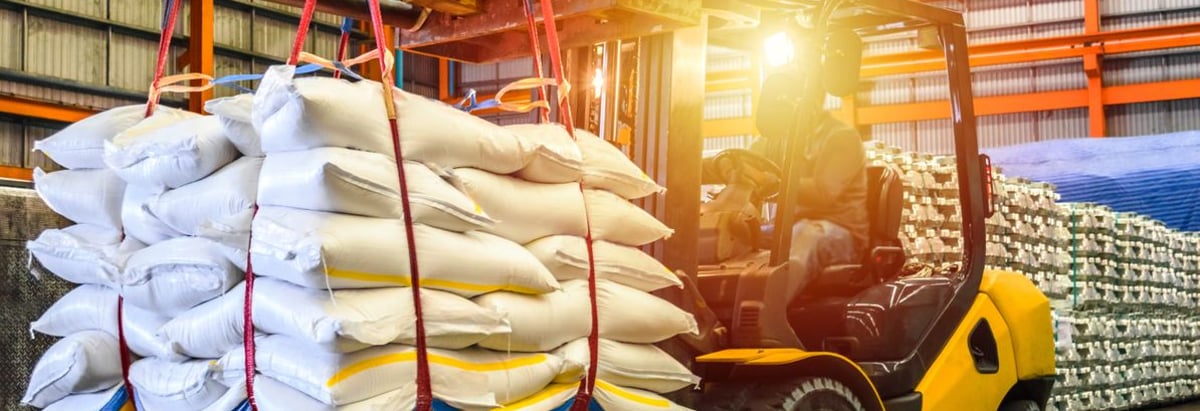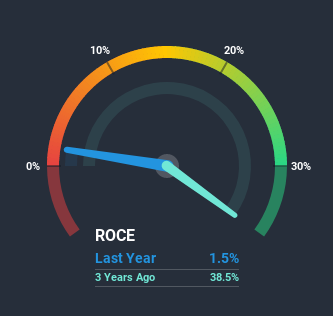- Hong Kong
- /
- Food and Staples Retail
- /
- SEHK:1705
What Do The Returns On Capital At B & S International Holdings (HKG:1705) Tell Us?

What trends should we look for it we want to identify stocks that can multiply in value over the long term? Ideally, a business will show two trends; firstly a growing return on capital employed (ROCE) and secondly, an increasing amount of capital employed. This shows us that it's a compounding machine, able to continually reinvest its earnings back into the business and generate higher returns. However, after investigating B & S International Holdings (HKG:1705), we don't think it's current trends fit the mold of a multi-bagger.
Return On Capital Employed (ROCE): What is it?
For those who don't know, ROCE is a measure of a company's yearly pre-tax profit (its return), relative to the capital employed in the business. The formula for this calculation on B & S International Holdings is:
Return on Capital Employed = Earnings Before Interest and Tax (EBIT) ÷ (Total Assets - Current Liabilities)
0.015 = HK$2.7m ÷ (HK$309m - HK$132m) (Based on the trailing twelve months to September 2020).
So, B & S International Holdings has an ROCE of 1.5%. In absolute terms, that's a low return and it also under-performs the Consumer Retailing industry average of 9.7%.
Check out our latest analysis for B & S International Holdings

While the past is not representative of the future, it can be helpful to know how a company has performed historically, which is why we have this chart above. If you're interested in investigating B & S International Holdings' past further, check out this free graph of past earnings, revenue and cash flow.
The Trend Of ROCE
In terms of B & S International Holdings' historical ROCE movements, the trend isn't fantastic. Around five years ago the returns on capital were 47%, but since then they've fallen to 1.5%. Meanwhile, the business is utilizing more capital but this hasn't moved the needle much in terms of sales in the past 12 months, so this could reflect longer term investments. It may take some time before the company starts to see any change in earnings from these investments.
On a related note, B & S International Holdings has decreased its current liabilities to 43% of total assets. So we could link some of this to the decrease in ROCE. What's more, this can reduce some aspects of risk to the business because now the company's suppliers or short-term creditors are funding less of its operations. Some would claim this reduces the business' efficiency at generating ROCE since it is now funding more of the operations with its own money. Keep in mind 43% is still pretty high, so those risks are still somewhat prevalent.
The Bottom Line
Bringing it all together, while we're somewhat encouraged by B & S International Holdings' reinvestment in its own business, we're aware that returns are shrinking. It seems that investors have little hope of these trends getting any better and that may have partly contributed to the stock collapsing 84% in the last three years. All in all, the inherent trends aren't typical of multi-baggers, so if that's what you're after, we think you might have more luck elsewhere.
If you'd like to know more about B & S International Holdings, we've spotted 5 warning signs, and 1 of them makes us a bit uncomfortable.
While B & S International Holdings isn't earning the highest return, check out this free list of companies that are earning high returns on equity with solid balance sheets.
If you decide to trade B & S International Holdings, use the lowest-cost* platform that is rated #1 Overall by Barron’s, Interactive Brokers. Trade stocks, options, futures, forex, bonds and funds on 135 markets, all from a single integrated account. Promoted
Valuation is complex, but we're here to simplify it.
Discover if B & S International Holdings might be undervalued or overvalued with our detailed analysis, featuring fair value estimates, potential risks, dividends, insider trades, and its financial condition.
Access Free AnalysisThis article by Simply Wall St is general in nature. It does not constitute a recommendation to buy or sell any stock, and does not take account of your objectives, or your financial situation. We aim to bring you long-term focused analysis driven by fundamental data. Note that our analysis may not factor in the latest price-sensitive company announcements or qualitative material. Simply Wall St has no position in any stocks mentioned.
*Interactive Brokers Rated Lowest Cost Broker by StockBrokers.com Annual Online Review 2020
Have feedback on this article? Concerned about the content? Get in touch with us directly. Alternatively, email editorial-team (at) simplywallst.com.
About SEHK:1705
B & S International Holdings
An investment holding company, distributes and retails food and beverage products in Hong Kong.
Flawless balance sheet, good value and pays a dividend.
Market Insights
Community Narratives



